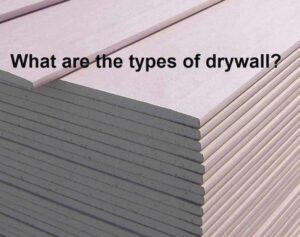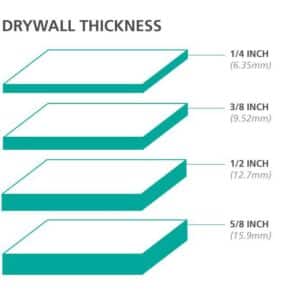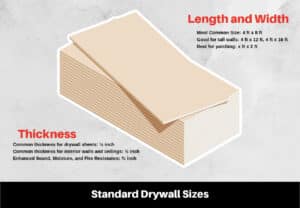
Welcome!... To Granite Kings
Drywall thickness is a crucial consideration when planning your project. The right drywall thickness ensures structural integrity and meets building codes. Understanding the type of drywall, size, and drywall thickness options is key. Standard drywall sheets are commonly used for interior walls and ceilings, but thicker options like fire-resistant or moisture-resistant drywall may be necessary.
When choosing the right drywall size and thickness, consider factors such as the size of the project, type of installation, and desired durability. Thicker drywall panels are suitable for curved walls or areas requiring extra support. This comprehensive guide to drywall thickness will help you select the right type and size for your residential or commercial construction needs.
Key Factors in Determining Drywall Thickness for Your Project
Determining the appropriate drywall thickness for your project involves several key factors. Firstly, consider the type of drywall suitable for your needs, whether it’s standard drywall or specialized options like moisture-resistant or fire-resistant variants. Next, evaluate the dimensions required, including the size of drywall sheets needed for your walls and ceilings.
Additionally, assess the specific application, such as curved walls or areas necessitating thicker drywall panels for enhanced support. Adhering to building codes and regulations ensures the right drywall thickness and type are selected, meeting safety standards for residential construction. This guide to drywall thickness options provides essential insights for selecting the ideal drywall for your interior walls and ceilings.
Expert Tips: Selecting the Optimal Drywall Thickness
Selecting the optimal drywall thickness for your project involves expert tips to ensure a successful outcome. Begin by assessing the specific requirements of your walls and ceilings, considering the type of drywall that best suits your needs. Take note of common thickness options and evaluate whether regular drywall or thicker variants are more appropriate, especially for areas with curved walls or requiring additional support.
Expert guidance is essential in navigating the different types of drywall, such as moisture-resistant or fire-resistant options, and understanding the nuances of drywall installation. This comprehensive guide provides valuable insights into the right drywall size and thickness, ensuring a seamless and compliant result in your residential construction or renovation project.
Top 5 Reasons To Choose Our Best Drywall Construction Company
Understanding Drywall Thickness: How it Affects Insulation & Soundproofing
Understanding the thickness of drywall is crucial when it comes to insulation and soundproofing. Thicker drywall, such as 5/8 inch, provides better insulation and soundproofing than thinner drywall, like 1/2 inch. Thicker drywall has a higher density and therefore offers more resistance to the transfer of heat and sound. This makes it ideal for rooms where insulation and soundproofing are important, such as bedrooms, home theaters, and recording studios.
Understanding the relationship between drywall thickness, insulation, and soundproofing can help homeowners and contractors make informed decisions when choosing the right materials for their construction or renovation projects, ultimately leading to more comfortable and efficient living spaces.
Practical Considerations: Matching Drywall Thickness to Wall Types
When considering practical considerations for matching drywall thickness to different wall types, it’s crucial to assess the specific needs of each area. Drywall thickness plays a pivotal role in ensuring structural integrity and optimal performance. For standard interior walls, a common thickness may suffice, but areas with curved walls or requiring additional support may necessitate thicker drywall panels.
Understanding the type of drywall suitable for each application, whether it’s moisture-resistant or fire-resistant, is essential. By carefully evaluating the thickness options available and selecting the right drywall size, you can ensure compliance with building codes and achieve the desired results in your residential construction or renovation project. Matching drywall thickness to wall types requires a comprehensive understanding of the various factors involved to make informed decisions for optimal outcomes.
For any questions please call us at (281) 790-8478
Types of Drywall for Different Wall Needs
When it comes to choosing the right drywall for different wall needs, it’s important to consider the specific requirements of each project. For standard interior walls, regular drywall is often sufficient. However, for areas that are prone to moisture or humidity, such as bathrooms or kitchens, moisture-resistant drywall is a better option. Fire-resistant drywall is also available for areas where fire protection is a concern, such as garages or utility rooms.
Additionally, for soundproofing purposes, there are specialized acoustic drywall options that can help reduce noise transmission between rooms. By understanding the different types of drywall available, it’s possible to select the most suitable option for any wall requirement.

Three Most Common Drywall Thickness for Your Walls
When it comes to choosing the right drywall thickness for your walls, there are three common options to consider. The most common thicknesses are 1/2 inch, 5/8 inch, and 3/8 inch.
The 1/2 inch option is ideal for most residential walls and ceilings, providing a good balance of cost and durability.
Meanwhile, 5/8 inch thick drywall is commonly used in areas that require extra protection and soundproofing, such as between walls in apartments or condominiums.
Finally, 3/8 inch drywall is typically used for patching existing walls or adding a thin layer over an already drywalled surface.
Understanding the differences between these thickness options can help you choose the right drywall for your specific project.

Optimizing Efficiency: Benefits of the Right Drywall Thickness
Optimizing efficiency through the right drywall thickness offers a myriad of benefits across various construction projects. By carefully selecting the appropriate drywall thickness, contractors can enhance installation speed and reduce material waste, thus optimizing resource utilization and minimizing project costs.
Additionally, the right drywall thickness ensures structural integrity, meeting building code requirements and enhancing the longevity of walls and ceilings. Whether it’s standard drywall or specialized variants like moisture-resistant or fire-resistant options, choosing the correct drywall thickness is crucial for achieving desired outcomes in residential and commercial construction endeavors. This strategic approach not only streamlines the construction process but also delivers superior performance and durability, making it a prudent investment for any project.
Step-By-Step – Mastering Drywall Finishing Like A Pro & Expert Tips
Best Practices for Installing Drywall of Various Thicknesses
When it comes to installing drywall of various thicknesses, it’s important to follow some best practices.
For thinner sheets of drywall, it’s crucial to use the correct length of fasteners to avoid damaging the material.
Thicker sheets may require more fasteners to ensure proper support and stability. It’s also important to stagger the seams when installing multiple sheets to prevent weak spots in the wall.
Additionally, using the right tools and techniques, such as using a drywall lift for larger and heavier sheets, can make the installation process much smoother.
Lastly, properly securing the drywall to the wall or ceiling frame and finishing the joints with tape and compound are essential steps in achieving a professional and durable result.
Standard Drywall Thickness Options
Standard drywall thickness options typically range from 1/4 inch to 5/8 inch, with the most common sizes being 1/2 inch and 5/8 inch. Thinner drywall (1/4 inch) is often used for curved walls, while 3/8 inch drywall is commonly used for repair work. The 1/2 inch thickness is the standard choice for most walls and ceilings, providing a good balance of cost and durability.
Thicker 5/8 inch drywall is commonly used on ceilings to provide better fire resistance and noise reduction. The choice of drywall thickness will depend on the specific requirements of the project, such as the type of wall or ceiling being constructed and any additional needs for soundproofing or fire resistance.

Fire-Rated 5/8-Inch Thick Drywall
Fire-rated 5/8-inch thick drywall is specifically designed to provide added protection in the event of a fire. This type of drywall is constructed with extra layers of gypsum to increase its fire resistance.
It is commonly used in areas where building codes require a higher level of fire protection, such as in residential garages, shared walls between townhouses or multi-family dwellings, and in commercial buildings.
The increased thickness and specialized construction of this drywall make it a reliable choice for fire containment. It is important to ensure that fire-rated 5/8-inch thick drywall is properly installed and maintained to maximize its effectiveness in providing fire protection for a property.
Choosing the Right Drywall Size
When choosing the right drywall size for your project, it’s important to consider the specific needs and requirements of the space. Larger rooms may require thicker drywall to provide better insulation and soundproofing, while smaller rooms may be adequately served by thinner sheets.
Additionally, the location of the drywall installation, such as high-traffic areas or moisture-prone areas, should also be taken into account when selecting the appropriate size.
It’s also crucial to consult with a professional to ensure that the chosen drywall size meets building code requirements and safety standards. Taking these factors into consideration will help you make an informed decision and ultimately result in a successful and long-lasting drywall installation.
To prepare a consultation please call us at (281) 790-8478
The Different Types of Drywall
Drywall, also known as plasterboard or wallboard, comes in different types with each suited for specific applications.
The most common type is regular drywall, which is suitable for most interior walls and ceilings.
Then there is moisture-resistant drywall, which is designed for areas with high humidity such as bathrooms and kitchens.
Fire-resistant drywall, on the other hand, is specially made to withstand high temperatures and is often used in garages or near fireplaces.
Another type of drywall is soundproof drywall, which has special materials to reduce noise transmission between rooms.
Finally, there is mold-resistant drywall, which is perfect for areas prone to moisture and mold growth.
It’s important to choose the right type of drywall for the specific needs of the project to ensure the best results.
Should I use 3 8 or 1 2 drywall for walls?
The decision to use 3/8 or 1/2 drywall for walls depends on several factors. Thinner 3/8 drywall is often used for curved walls or ceilings, while the thicker 1/2 drywall is commonly used for standard walls. In some cases, 1/2 drywall may be preferred for its added durability and soundproofing qualities. However, 3/8 drywall can be easier to work with and a more cost-effective option for certain projects.
It’s important to consider the specific needs of the wall, such as its location, the potential for moisture, and the desired level of insulation. Consulting with a professional or researching the specific requirements of the project can help determine the best option for your walls.
Should I use 1 2 or 5 8 drywall in my garage?
The decision to use 1/2 or 5/8 drywall in your garage ultimately depends on the level of durability and protection you desire. 1/2-inch drywall is suitable for most garage walls and ceilings, providing adequate protection and insulation. However, if your garage is subject to higher levels of wear and tear, such as heavy equipment or potential impact from tools, 5/8-inch drywall may be a better choice for its increased strength and durability.
Additionally, 5/8-inch drywall can provide better fire resistance and soundproofing, making it a good option for attached garages or workshops. Consider the specific needs and usage of your garage to determine the best drywall thickness for your project.
Do commercial buildings use 5 8 drywall?
Commercial buildings often use 5/8 drywall due to its enhanced fire-resistance and soundproofing properties. This thicker drywall is commonly chosen for commercial spaces such as office buildings, hotels, and retail stores where safety and privacy are key considerations. The additional thickness of the 5/8 drywall provides a higher level of protection in the event of a fire, and it also helps to reduce noise transmission between rooms and floors.
These factors make 5/8 drywall a popular choice for commercial construction projects, where meeting building codes and providing a comfortable and secure environment for occupants is a priority. Additionally, the durability and ease of installation of 5/8 drywall make it a practical choice for commercial buildings, where it can withstand high traffic and frequent renovations.
What is the best thickness of drywall?
The best thickness of drywall depends on the specific needs of the project. For most residential interior walls and ceilings, 1/2-inch thick drywall is commonly used. It provides a good balance of strength and flexibility while still being easy to work with during installation.
However, for areas that require more durability, such as high-traffic areas or where shelving and heavy items will be installed, 5/8-inch thick drywall is often recommended.
Additionally, for soundproofing or fireproofing, one might choose to use even thicker drywall. It’s important to consider the specific requirements of the space and consult with a professional to determine the best thickness of drywall for the job.
Why do interior walls need to be 5 8 inches?
Interior walls need to be 5/8 inches thick in order to provide sufficient support and strength for the structure of a building. Thicker walls are also better able to withstand the wear and tear of everyday use, as well as providing better insulation for temperature control and soundproofing.
Additionally, thicker walls can support the weight of heavier fixtures and furniture that may be mounted on them. In regions with extreme weather conditions, thicker walls can also offer increased protection and stability.
Overall, the 5/8 inch thickness requirement for interior walls is crucial for ensuring the durability, safety, and longevity of a building’s structure, as well as providing a comfortable and functional living space for its occupants.
Is lightweight drywall as good as regular drywall?
Lightweight drywall is a popular alternative to regular drywall due to its ease of installation and reduced strain on the structure. It is made with a mix of different materials, making it lighter and easier to handle. While lightweight drywall is just as strong and durable as regular drywall, it may not be as effective in soundproofing and fire resistance.
It is suitable for most residential and commercial applications, but for areas that require extra protection against noise or fire, regular drywall may be a better option. Ultimately, the choice between lightweight and regular drywall depends on the specific needs of the project and the desired level of performance in terms of soundproofing and fire resistance.
Finishing Touches: Drywall Tape and Texture
When it comes to finishing touches in a construction project, drywall tape and texture play a crucial role in achieving a polished and professional look.
Drywall tape is used to reinforce the seams between drywall panels, ensuring a smooth and seamless surface for painting or wallpapering.
There are different types of drywall tape available, including paper tape and self-adhesive mesh tape, each with its own advantages and application methods. Once the drywall seams are taped, texture is applied to create visual interest and cover up any imperfections.
Texture options range from simple smooth finishes to more elaborate patterns like knockdown or orange peel. Both drywall tape and texture are essential elements in the final stages of finishing a construction project, providing a clean and attractive surface for interior walls.
Complying with Building Codes
Complying with building codes is crucial for ensuring the safety and structural integrity of a building. Building codes are put in place to establish minimum standards for construction to protect public health, safety, and general welfare. It is important for architects, engineers, and builders to adhere to these codes to prevent potential hazards and disasters such as building collapses, fires, and other life-threatening situations.
By following building codes, construction professionals can also ensure that buildings are accessible to individuals with disabilities and are equipped with proper ventilation, heating, and electrical systems. In addition to safety concerns, complying with building codes can also prevent legal and financial repercussions for building owners and developers. Therefore, it is essential to always stay informed about and comply with current building codes for any construction project.

